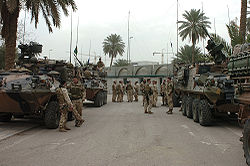| Deployment | Dates | Composition | Notes |
|---|
| SECDET | May–September 2003 | - V32A patrol- C Squadron, 2nd Cavalry Regiment.
- 5 Platoon, B Company, 2 RAR [6]
- 1st MP Bn
EOD Team from 3rd Combat Engineer Regiment | |
| SECDET II | Sep 2003 - Jan 2004 | - V12 - A Squadron, 2nd Cavalry Regiment
- A Company, 2 RAR [6]
- 1st MP Bn
| |
| SECDET III | 2004 | - 3 Troop, B Squadron, 2nd Cav Regt
- A Company, 3 RAR [6]
- 1st MP Bn
| |
| SECDET IV | 2004 | - 3 Troop C Squadron, 2 CAV REGT
- D Company, 5/7 RAR [6]
- 1st MP Bn
| |
| SECDET V | 2004 | - 3 Troop A Squadron, 2 Cav Regt
- C Company, 5/7 RAR [6]
- 1st MP Bn
| |
| SECDET VI | 2004 | | |
| SECDET VII | 2004–05 | - C Company, 6 RAR
- Troop, 2/14 LHR (QMI) [7]
- 1st MP Bn
| SECDET VII had a strength of approx. 60 soldiers [7] |
| SECDET VIII | 2005 | | |
| SECDET IX | 2005–06 | - Support Company, 3 RAR
- Troop, 2/14 LHR (QMI)
- Elements, 1st MP Bn [9]
| Private Jacob Kovco was a member of SECDET IX [9] [5] [3] |
| SECDET X | 2006 | - A Company, 3 RAR
- Elements, 2 Cavalry Regt and 2/14 LHR (QMI)
- Elements, 1st MP Bn [9]
| |
| SECDET XI | 2007 | - A Company, 1 RAR
- Troop, 2/14LHR (QMI)
- Elements, 1st MP Bn
- Combat Service Support Element [10]
| |
| SECDET XII | 2007 | - D Company, 6 RAR
- Troop, 2/14 LHR (QMI)
- Elements, 1st MP Bn
- Combat Service Support Element [11]
| |
| SECDET XIII | 2008 | - A Company, 7 RAR
- Troop, 2nd Cavalry Regt
- Elements, 1st MP Bn
- Combat Service Support Element [12]
| The infantry component included a section of RAAF Airfield Defence Guards
from No. 2 Airfield Defence Squadron |
| SECDET XIV | 2008–09 | - Combat team HQ, B Sqn, 2nd Cavalry Regiment
- two infantry platoons, 5 RAR
- 3 Troop, B Sqn, 2nd Cavalry Regt
- Elements, 1st MP Bn
- Combat Service Support Element [13]
| The infantry platoons were reinforced by members of No. 2 Airfield Defence Squadron [14] |
| SECDET XV | 2009 | - Company HQ and two infantry platoons, 2 RAR
- Troop, 2nd Cavalry Regt
- Elements, 1st MP Bn
- Combat Service Support Element [14]
| |
| SECDET XVI | 2010 | - 2/14 LHR (QMI) Headquarters
- Cavalry Scout Troop from 2/14 LHR QMI (A & C SQN)
- Elements, 1st MP Bn
- Combat Service Support Element [14]
| Transition from ASLAV based patrols to upgraded B6 armoured vehicles, then handing over to URG. Last Detachment to SECDET with frontline involvement and drew down from approx. 80 personnel to under 10 on SECDET XVII (HQ only). |
